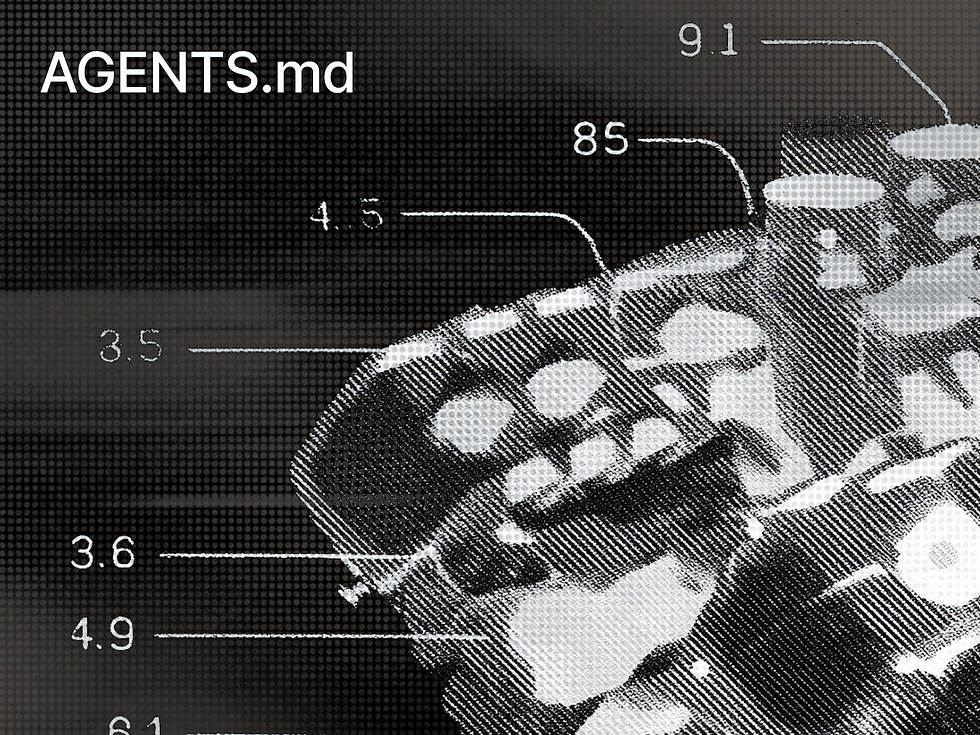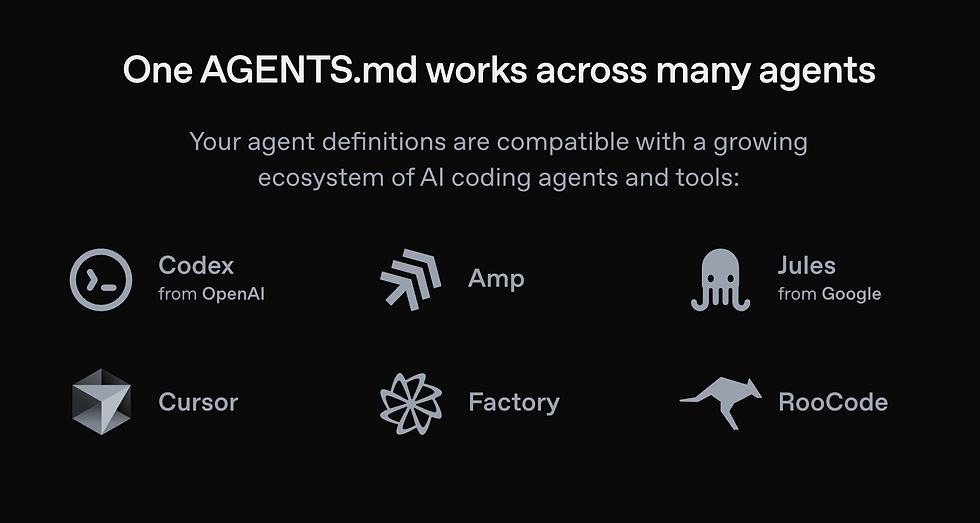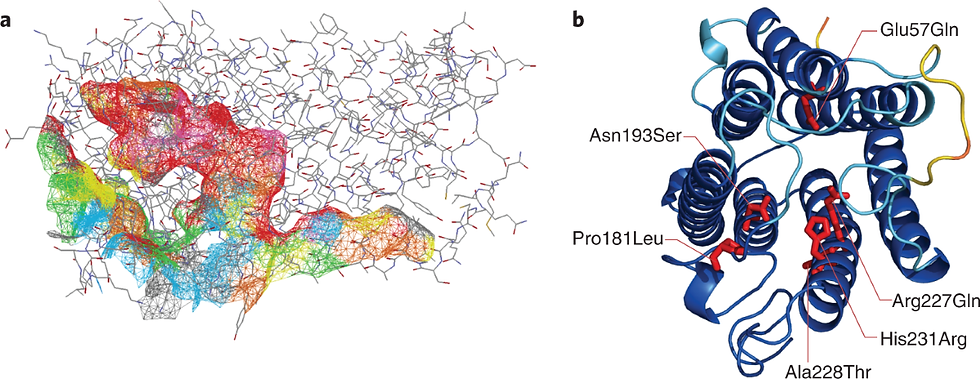What Is Agents.md? A Complete Guide to the New AI Coding Agent Standard in 2025
- Olivia Johnson

- Aug 22
- 12 min read

What is Agents.md and why the 2025 AI coding agent standard matters

Agents.md is the emerging 2025 open standard for AI coding agents — a machine-readable manifest and protocol suite designed to make AI coding agents interoperable, auditable, and portable across platforms. In short, Agents.md is the specification layer that lets independent models, runtimes, tool adapters, and developer tooling speak a common language about what an agent can do, how it should behave, and which safeguards must be enforced.
Why should you care? Because standards determine what becomes composable in production. Without a shared protocol, developers will keep building bespoke scaffolding for agent behavior, increasing fragmentation, audit pain, and security risk. With Agents.md, teams can expect interoperable manifests, consistent telemetry, and a governance surface that fits into existing compliance tooling.
The announcement at Microsoft Build 2025 — the launch moment
Microsoft framed the move as an industry pivot: agents will be first-class components of software platforms, and their behavior must be open, discoverable, and governable. The Build presentation emphasized two themes: openness (vendors should interoperate) and responsibility (auditable policies and human control). That messaging anchored Agents.md as a shared starting point rather than a proprietary lock-in. Independent landscape analysis published earlier in 2025 had already called for such a coordination point to curb fragmentation and accelerate safe adoption.
Quick snapshot — what Agents.md aims to standardize
At a high level, Agents.md focuses on:
Agent rules files and manifests that declare identity, intents, permissions, and resources.
Interchange file formats (JSON/YAML schemas) to make definitions portable.
Agent lifecycle events and a standard runtime API surface for planners, executors and tool adapters.
Discovery protocols and registries for agent discovery and capability advertisement.
Why this matters: standardization enables tooling (marketplaces, registries), enterprise governance (policy enforcement, auditing), and community-built adapters. In other words, the spec aims to make AI coding agents reliable infrastructure components rather than isolated experiments.
Agents.md specification and core concepts — What the Agents.md standard defines

Agents.md is built around a small set of composable primitives meant to cover typical coding-agent needs while remaining extensible for vendor-specific features. At its heart are agent manifests (machine-readable declarations of intent and capabilities), an interchange schema for file formats, and a standardized runtime API for lifecycle and telemetry.
Agent manifest: a declarative file that describes an agent’s identity, capabilities, triggers, permissions and resource bindings (defined below at first use).
The design goals are clear: interoperability, human-in-the-loop safety hooks, and robust versioning/compatibility. These priorities reflect both community requests for portability and enterprise needs for auditable operations.
Core components: manifest, formats, APIs, and execution semantics
Agent manifest (rules file): declares identity, behavioral rules, capability interfaces, resource claims (e.g., repo read/write), and lifecycle policies.
File formats: canonical JSON Schema and optional YAML serialization, with extension hooks for vendor metadata.
Runtime API: evented lifecycle (create, plan, approve, execute, complete, audit), telemetry hooks, and action/plan interfaces for tool invocation.
Execution semantics: a planner generates steps or plans; an executor guarantees atomic application of safe actions (with sandboxing and rollback where required).
These elements are designed to make AI coding agents portable: the same manifest should be interpretable by different runtimes and verifiable by registries or governance tooling.
Design goals explained
Interoperability: Agents.md’s interchange schema and runtime API are intentionally minimal yet expressive, so third-party tool adapters can implement mapping layers without reengineering core behavior. This aligns with the community push described in landscape reports for a shared schema to reduce fragmentation.
Human-in-the-loop safety hooks: the spec mandates checkpoint events where humans can approve or veto actions; it also prescribes telemetry and signed manifests to ensure traceability for every decision.
Versioning and compatibility: manifests include schema versioning, backward compatibility rules, and migration guidance so registries can manage agent upgrades safely.
Key takeaway: Agents.md balances simplicity and extensibility — it defines the minimum necessary surface to make agents portable while enabling richer vendor extensions.
Agent manifest and rules files — structure and semantics
An agent manifest is the canonical artifact Agents.md defines. Typical fields include:
id and version — unique identity and semantic versioning.
displayName and description — human-friendly metadata.
capabilities — declared functions (e.g., code-modify, test-run, dependency-update).
triggers — event sources (e.g., PR opened, scheduled cron).
permissions — resource scopes (repo read, repo write, CI trigger).
safetyRules — policy hooks (humanApproval: required/optional, sandboxMode).
resources — external connectors or secrets needed (with references to secret managers).
telemetryConfig — what to emit and where.
Rules files (sometimes separate from manifests) express policy constraints: for example, “no direct write to main branch without human sign-off” or “only update dependencies within minor version bumps.” Agents.md supports both embedded policies and external rule references, favoring least-privilege and sandboxing by default. This design reduces blast radius and eases enterprise governance.
File formats and interchange — JSON/YAML schemas and extension points
Agents.md recommends:
A single canonical JSON Schema for machine verification and CI checks.
Optional YAML for readability in repositories and human review.
Extension fields prefixed with vendor metadata namespaces to avoid collisions (e.g., x-vendor: { ... }).
Schema evolution is addressed by explicit version fields and compatibility rules; runtimes must declare their supported schema versions in capability negotiation. Extension hooks let vendors expose features (e.g., custom sandbox modes) while registries validate base compliance. This balances human-readability and machine-verifiability, which both matter for developer adoption and automation.
Runtime & API surface for coding agents
The spec defines a small, event-driven API surface:
Lifecycle events: onRegister, onPlanRequested, onPlanProduced, onApprovalRequested, onExecuteStart, onExecuteComplete, onAuditLogCreated.
Plan/action interface: plan objects contain ordered steps, low-risk dry-run artifacts (diffs), and required approvals.
Telemetry hooks: standardized event schemas for actions, decisions, and errors.
Developer callbacks: webhooks for CI, VCS, and observability platforms.
Agents.md formalizes the planner-executor split: planners produce structured plans (human-readable plus machine-verified diffs) and executors apply them with sandbox guarantees. This prevents planners from implicitly triggering any system change without the executor's enforcement of permissions and rollback semantics.
Security, observability, and auditing baked into the spec
Security features include:
Signed manifests and signed run records to bind identity to actions.
Immutable run records and provenance chains for incident investigation.
Standard telemetry schemas to align logs across vendors.
Observability and auditing are first-class: every plan, approval, and executor action is recorded using a standard schema so governance tools can analyze behavior across agents. These controls make Agents.md attractive to regulated industries and risk-aware engineering teams.
Key takeaway: Agents.md is not just a manifest format — it’s a governance-aware API and telemetry contract intended to make agent actions auditable, portable and safe.
How Agents.md works — protocols, frameworks and agentic architecture

Agents.md operates at the intersection of protocol definitions and runtime patterns. It prescribes how agents are discovered, negotiated with, and executed inside an agentic architecture composed of planners, executors and tool adapters.
Agent discovery: the process by which hosts find agents and evaluate their suitability. Capability negotiation: runtime exchange confirming an agent can safely perform requested actions.
This section draws on community playbooks for agent protocols and practical frameworks for agentic coding workflows.
Discovery and capability negotiation
Discovery typically happens through:
Local registries (repo-level agent manifests).
Centralized agent registries or marketplaces.
In-band capability advertising (agents announce runtime capabilities via a metadata handshake).
Capability negotiation uses signed claims and scope-limited tokens. Hosts must validate an agent’s rights (proof-of-rights) for requested resources before handing over secrets or permissions. Agents.md recommends short-lived tokens and cryptographic attestations so hosts can make decisions based on verifiable claims.
Security considerations are central: discovery should be permissioned, and capability negotiation should reject agents that request privileges beyond their manifest. This reduces accidental over-privilege during automation and prevents supply-chain abuse.
Planner-executor pattern in Agents.md
Agents.md codifies a planner-executor separation:
Planner: a low-privilege component (often model-backed) that ingests issues or triggers, queries context (tests, code), and emits a structured plan: step list, diffs, tests to run, expected side effects.
Executor: a permissioned runtime that interprets the plan, interacts with tool adapters (VCS, CI), and enforces security policies (sandboxing, approvals, rollback).
Planner outputs are intentionally deterministic artifacts (diffs and test plans), not opaque instructions. Executors must validate the plan against the manifest and enforce least-privilege. Typical planner outputs include:
Ordered step lists (e.g., create branch, modify files, run tests).
Patch/diff artifacts that can be reviewed or applied atomically.
Test harness invocations and expected success criteria.
This pattern reduces risk: because the executor validates and enforces, planners cannot bypass permissions even if compromised. See community playbooks for practical examples of planner-executor pipelines in coding workflows.
Tool adapters and sandboxing for coding agents
Agents.md defines standard adapter interfaces for common automation touchpoints:
VCS adapters: create branches, push commits, open pull requests.
CI adapters: trigger pipelines, fetch artifacts, report statuses.
Build and package managers: run builds, publish packages under policy.
Secret managers: scoped secret retrieval with audit hooks.
Sandboxing modes are explicit in manifests: dry-run only, restricted sandbox (read-only on repos), and full-run with explicit human approval. Sandboxing reduces supply-chain risk by default and allows safe evaluation in staging. Tool adapters implement the translation between high-level plan steps and vendor-specific APIs, but must honor the manifest’s permission model.
Telemetry, fault handling, and rollback strategies
Agents.md prescribes a telemetry schema that captures:
Plan provenance: which agent made the plan, which model version, and what data was used.
Execution traces: step start/stop times, success/failure status, artifacts produced.
Approval events and human decisions.
For faults, the spec recommends:
Graceful degradation: fail fast and mark plans as aborted with clear reasons.
Automatic rollback for partial failures, with a “safe state” definition embedded in manifests.
Human-in-the-loop checkpoints for high-risk operations so rollback or mitigation can be manual if needed.
These measures enable reliable incident analysis and facilitate compliance reporting. They’re also practical: teams adopting Agents.md saw reduced incident time-to-resolution because audit trails made root-cause analysis faster in early pilots.
Key takeaway: Agents.md formalizes the interactions between discovery, planner, executor and adapters, enabling secure, auditable automated coding workflows.
Market adoption, trends and use cases for Agents.md in 2025

Agents.md enters an ecosystem that’s already seeing rapid uptake of AI agents. Index.dev and other aggregators reported early signals of agent usage growth in developer tooling and CI pipelines in 2025, and pragmatic analyses highlight accelerating interest in standards to manage fragmentation.
Quantitative adoption signals (downloads, integrations, active agents)
Early KPIs to watch:
Number of agent manifests published in public registries.
Active agents per repository (agents that executed at least once in the past 30 days).
CI pipelines with agent-triggered runs.
Marketplace downloads and adapter installations.
Dashboards at index.dev and pragmatic community trackers showed upward trends in Q1–Q2 2025: rising downloads for agent adapters, growth in agent-enabled PRs, and more CI workflows invoking agents. These are early but meaningful adoption signals that inform enterprise decisions.
Developer productivity and workflow improvements
Common developer use cases where Agents.md helps:
Automated issue triage: agents classify and assign issues based on manifest rules and repo heuristics.
Automated code generation and PR creation: agents produce small refactor PRs (with tests) and submit them for review.
Test creation and maintenance: agents generate or update unit tests based on changed code or behavior.
Automated refactoring and dependency updates: agents propose minor version upgrades, run tests, and open PRs.
CI automation: agents triage failing builds, create rollback PRs, or trigger patch releases.
Concrete metrics teams can expect include reduced PR lead time, faster bug resolution, and fewer manual merges. Index.dev’s reports indicate agent-enabled workflows can lower routine PR cycle time by measurable margins in pilot environments, especially for dependency maintenance and test scaffolding.
Insight: Agent productivity gains are highest for repetitive, well-scoped tasks (dependency bumps, test scaffolding). Complex architectural changes still need human architects.
Emerging verticals and enterprise scenarios
Early vertical adopters include:
Platform engineering: agents manage internal libraries, automate upgrades, and maintain infra-as-code.
Fintech: careful manifests and signed provenance make agents attractive for regulatory compliance when automating customer-facing code.
Large open-source projects: agents handle triage, apply canonical formatting, and manage dependency hygiene across many repos.
Agents.md’s registry and marketplace model enables cross-vendor portability: enterprises can select agents from vendors, verify manifests, and trust a common telemetry schema. This supports open agentic web scenarios where independent agents cooperate across services while preserving governance boundaries.
Key takeaway: Agents.md accelerates an open ecosystem by standardizing manifests and telemetry, and early signals show measurable developer productivity improvements for routine tasks.
Challenges, standardization debates, and policy for Agents.md

Despite clear benefits, Agents.md adoption raises hard questions: fragmentation risk, supply-chain security, and governance. Thought leaders and enterprise guides have already framed these debates and suggested paths forward.
File fragmentation and format interoperability
Too many proprietary manifest formats would defeat Agents.md’s purpose. The spec counters this with a canonical JSON Schema, extension namespaces and migration guidance. Migration paths for legacy agent definitions include automated converters and adapter shims; registries can provide compatibility profiles to ease adoption. Still, community governance is essential: consistent validation tooling and certification programs will reduce fragmentation risk.
Mitigation strategy: adopt Agents.md’s canonical schema, run automated scans for non-compliant manifests, and use conversion tools in CI to normalize legacy formats.
Safety, supply-chain and attacker surface
Autonomous code-writing agents broaden the attack surface. Threat scenarios include malicious manifests, compromised tool adapters, or agents that introduce vulnerable dependencies. Recommended hardening steps include:
Signed manifests and signed run records to verify origin and integrity.
Provenance tracking for dependencies and code changes.
Scoped secrets and short-lived tokens.
Sandbox-only modes for untrusted agents or initial evaluations.
These measures are already seen in enterprise guidance and the IBM analysis on expectations vs. reality for AI agents.
Governance, auditability and legal compliance
Agents.md supports governance with manifest signing, immutable run records and telemetry schemas that feed into existing audit systems. For regulated environments, teams should:
Enforce policy profiles for manifests (approved capabilities, allowed resource scopes).
Keep signed trails of approvals and rollbacks.
Map agent activities to compliance controls during audits.
However, legal questions remain: who is accountable for agent-created code? Agents.md helps by making actions auditable, but organizations must define human accountability and operator control in their contracts and internal policies.
Standards bodies, community governance, and next steps
Sustainable stewardship is crucial. Likely participants in Agents.md governance include cloud vendors, open-source foundations, standards bodies and community working groups. Roadmap priorities:
Reference implementations and certified runtimes.
Compliance profiles for regulated verticals.
Certification programs and agent registries that verify manifest compliance.
Community-led working groups should prioritize compatibility tests, security profiles and a public test suite. These concrete deliverables will drive convergence and confidence in the standard.
Key takeaway: Agents.md addresses many governance and security needs, but adoption must be coupled with certification, registries, and legal clarity to fully mitigate risk.
Developer adoption checklist — implementing Agents.md in your engineering workflows

If your team is ready to adopt Agents.md, follow a practical rollout path that balances learning with risk control. Community-guides and practitioner reports emphasize staged pilots and clear observability baselines.
Quick-start checklist
Evaluate Agents.md-compliant tooling:
Choose a runtime and registry that supports the canonical JSON Schema.
Select vendor adapters that map to your VCS, CI, and secret manager.
Run a constrained pilot:
Pick low-risk repositories (documentation, infra scripts).
Start in sandbox or dry-run mode.
Define safety policies:
Manifest signing requirement, minimum approval gates, and audit retention periods.
Integrate telemetry and observability:
Configure telemetry sink to correlate agent runs with incidents and CI events.
Measure and iterate:
Track success metrics and developer feedback; expand scope when confident.
Actionable:Run an Agents.md pilot that updates a documentation repo or bump dependencies on a small service as your first real-world experiment.
Pilot checklist — how to run a safe, measurable pilot
Define scope: single repo, defined agents, and clear success criteria (e.g., 90% of auto-PRs pass tests).
Choose low-risk repos: docs, infra, or experimental services.
Establish telemetry baselines: PR lead time, failure rate, and false positives.
Schedule human review windows: require human approval for writes to protected branches.
Timeboxed run: Evaluate after 4–8 weeks and adjust policies.
References from practitioners recommend this measured approach to reduce surprises and build confidence prior to broader rollout.
Integrations — critical adapters and automation touchpoints
Start with these adapters:
VCS adapter (branching, PR creation).
CI adapter (trigger runs, read test results).
Secret manager adapter (scoped access only).
Observability and incidenting adapter (forward telemetry to SIEM or logs).
Prioritize test harness integration and incident alerting so agent actions are visible to SREs and security teams.
Organizational readiness — roles, training, and policy enforcement
Create these roles:
Agent owner: responsible for agent manifests and policy alignment.
Security reviewer: validates manifest permissions and sandbox modes.
SRE integration lead: ensures telemetry and incident workflows are hooked up.
Training topics:
Manifest review and threat modeling.
Rollback procedures and incident drills for agent actions.
Monitoring agent lifecycle events and reading provenance trails.
Key metrics to track: PR lead time, false positive changes (human reversals), agent success rate, and developer satisfaction. These will help quantify ROI and guide safe expansion.
Key takeaway: Start small, instrument everything, and define clear ownership to scale Agents.md adoption safely.
FAQ — common questions about Agents.md and AI coding agent standards
Q: What exactly is Agents.md? A: Agents.md is a standardized manifest and protocol specification for AI coding agents to enable interoperable, auditable agent behaviors across platforms.
Q: Is Agents.md tied to a single vendor or model? A: No — the spec is intentionally vendor-agnostic to support cross-vendor interoperability among multiple LLMs, runtimes, and tool providers. Industry playbooks emphasize this goal.
Q: Will Agents.md replace existing agent frameworks? A: No — it complements them by providing a common interchange and governance layer. Existing frameworks can adopt Agents.md manifests to interoperate with other tools and registries.
Q: What safety features are required by Agents.md? A: The spec recommends manifest signing, standardized telemetry, human-approval gates, and least-privilege runtime modes including sandbox-only options. These features are designed to support auditability and supply-chain protection.
Q: How can my team start using Agents.md today? A: Begin with a scoped pilot: integrate a compliant manifest into a staging workflow, enable sandbox/dry-run modes, and adopt telemetry and rollback policies. Practical guides and pilot checklists outline exactly these steps.
Q: Where will real-world case studies appear? A: Early case studies are likely to surface in platform provider blogs, community working groups, and conference reports as adoption grows during 2025. Keep an eye on Microsoft Build follow-ups and independent landscape trackers for emerging examples.
Conclusion — Actionable insights, next steps, and the future of Agents.md

Agents.md introduces a foundational interoperability layer for AI coding agents in 2025 — one that balances openness with governance and makes the open agentic web a practical possibility. It provides manifests, runtime contracts, telemetry standards and security primitives that address many early-adoption pain points.
Actionable next steps:
Run an Agents.md pilot in a low-risk repo with sandboxed agents and strict approval gates.
Adopt manifest signing, observability, and rollback policies as default.
Participate in standards discussions and working groups to influence certification, registries and reference implementations.
Expect the ecosystem to mature through 2025–2026 with certification programs, public agent registries, and richer governance tooling built on top of Agents.md. Organizations that start pilots now will have a head start in operational experience and in shaping the standard’s trajectory.
Final takeaway: Agents.md is not just a file format — it’s the coordination fabric for how AI agents will safely and productively participate in software engineering. Align early, pilot carefully, and help shape the standard as it moves from spec to mainstream infrastructure.


